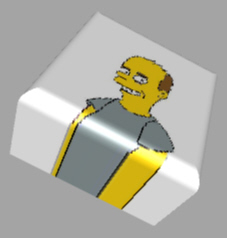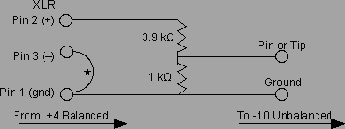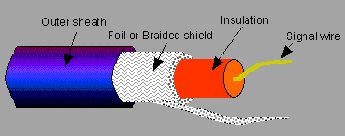

Balancing Act
How you connect mic's and other audio equipment can make a big difference in the quality of your audio signal.
Why wires are noisy
The problem is that wires are also antennas. When you plug a mic into a Mixer, or a CD player into your audio system, you don't just get the desired signal. Any nearby electric fields are also picked up on the wire, adding a slight voltage which the equipment can't distinguish from the desired audio.
You can't avoid these fields. They're created by any other wires that carry a current. This includes video, and computer data cables, which can add all sorts of high-frequency whines and whistles to your audio.
Manufacturers reduce this antenna effect in a signal wire by wrapping a shield around it, usually a copper braid or metal foil. The shield is connected to ground and shorts out the interference before it can reach the signal wire in the center of the cable. That's why phono, BNC, and cable TV plugs have a center pin and outer metal shell: the pin is signal, and the shell carries the shielding that in the wire.
A typical shielded cable.
About ground loops
That's fine for a single piece of equipment, but when you hook two devices together, both have to agree on the reference. Since the cable shield has to be grounded at least at one end, the usual scheme is to use it to connect the two devices reference points together. It works in very simple systems.
But remember, that shield is picking up hum from the building wiring. And if the shield is carrying current something unavoidable if it's part of the audio path -- it has a slight voltage drop. Both these factors mean that the two devices are going to have slightly different references, and the difference is constantly varying. The input circuit can't tell that this variation isn't part of the signal, so it amplifies it. But in a complex room or studio it becomes hum and noise.
Another advantage of balanced wiring
Answer: it does. Noises from nearby video or computer cables are picked up on each conductor. But remember, a balanced audio input cares only about the voltage difference between the two wires. Interference is radiated equally into each wire. Since the interference is equal on each, there's no voltage difference from it! The balanced input can't even see that the noise is there.
Or to put it into a chart:
Conductor Audio Signal Noise Total on wire
Black +1 v +1 v +2 v
White -1 v +1 v 0 v
Transmitted difference 2 v Received difference 2 v
"Star Quad" is four-conductor shielded balanced cable. The four wires form a tighter, more consistent pack than two wires can and can resist even more noise. If you're using Star Quad, you must tie the two pairs of similarly-coloured wires together at each end... reducing it effectively to two conductors. Don't try to use it as two balanced pairs for two different signals: this won't give you any noise-reduction benefits at all.
You can't tell a wire by its connector.
You can also get into trouble assuming that other kinds of connectors aren't balanced. Some manufacturers save money and space by putting balanced signals on three-conductor phone jacks. From the front panel, these look identical to two-conductor unbalanced jacks.
But if you connect a three-conductor phone plug -- also known as Tip-Ring-Sleeve, or TRS -- it can carry a balanced signal. Again, check the specs.
And a balanced connection works only if both ends are balanced. If either of the two internal wires are shorted to ground at either end, the whole thing becomes unbalanced.
This can happen easily if:
- You plug one end into an unbalanced circuit
- You use most kinds of XLR-to-Phone or -RCA adapters
- The cable is damaged
Got balanced wiring on a TRS jack (found in many compact mixers)?
The worst thing you can do is split it to two channels with a stereo Y cable. You'll hear a signal on each end of the Y, but the two signals will be of opposite polarity. If you then listen in mono, they'll cancel each other and the sound will disappear!
Connecting balanced and unbalanced equipment
Connecting an unbalanced consumer output to a balanced professional input -- say, from a sound card to a professional mixer -- is slightly more complicated, because the voltage levels are different as well. For this situation, the best bet is to get a balanced interface for the computer. This is a small powered box with an unbalanced input at -10 dBV (usually on an RCA jack) and balanced output at +4 dBm (usually on an XLR male). Run a very short cable from the source to the RCA jack, and as long a balanced XLR cable as you need to the pro equipment. Similar interfaces are available to connect balanced sources to unbalanced equipment.
If you don't need balanced wiring and don't care about levels, start with the schemes below. They'll work with most modern equipment... but there are some oddballs.
* - You'll need this jumper if the source has a transformer output.
It may cause problems with transformerless devices.
An unbalanced wiring trick
- Use the same kind of two-conductor shielded cable as you'd use for balanced wiring.
- Connect the "hot" conductor -- usually white -- to the center pin of the phono or phone plug at each end.
- Connect the other conductor to the sleeve of each plug.
- Now here's the trick" connect the cable's braided or foil shield to the sleeve at one end only. Use shrink wrap or tape to make sure the shield doesn't touch anything at the other end.
- Be consistent about which end of the shield gets connected... one way is to always connect the shield at your patchbay or mixer, and always leave the other disconnected.


Balanced Wiring
Balanced wires also reject noise that isn't coming from a ground loop. The two conductors are twisted closely together, so any interference radiated into the cable is picked up equally by both. But remember: the equipment is looking for a voltage difference between those wires. Noise is the same on both wires, so the equipment can't hear it.

* - Some balanced phone-plug inputs are designed so that you can plug an unbalanced two-conductor plug directly into them.
Conductor XLR TRS Phone
Ground
(No Connector)
- Pin 3 Ring
Shield Pin 1 Sleeve*
* - If the source has a transformer output (some high-end gear and most of the classic stuff), connect this to ground as well.
If you want to connect a +4 dBm professional balanced source to -10 dBV unbalanced consumer equipment, and you don't care about balancing but you do want to adapt the level, get some resistors at CPC.
XLR TRS Phone Conductor
Pin 2 Tip +
Pin 3 Ring -
‘ Sleeve Shield
Unbalanced Input
Signal
(no Connection) *
Ground




